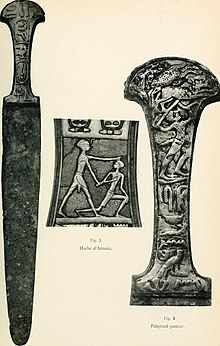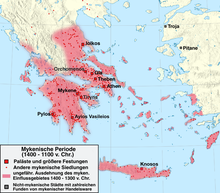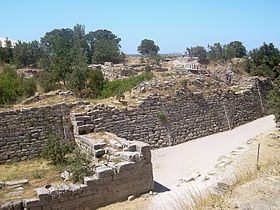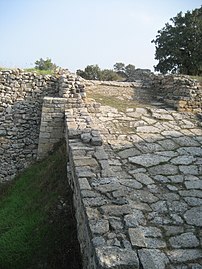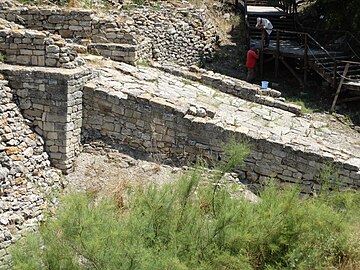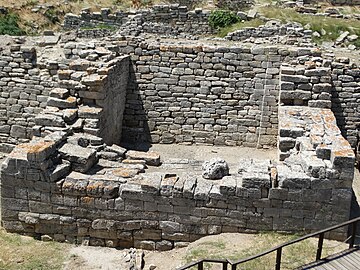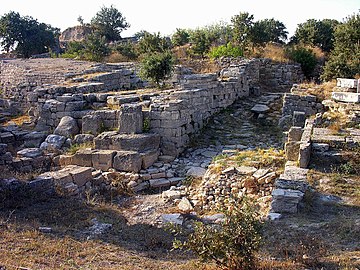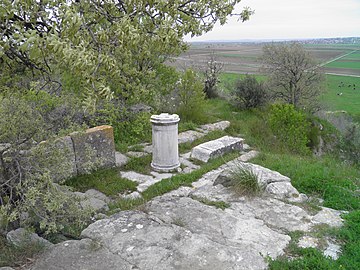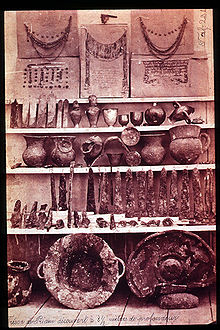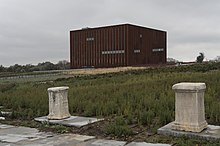From Wikipedia, the free encyclopedia
Troy (Greek: Τροία) or Ilium (Greek: Ίλιον) was an ancient city located at Hisarlik in present-day Turkey, 30 kilometres (19 mi) south-west of Çanakkale. It is known as the setting for the Greek myth of the Trojan War.
In Ancient Greek literature, Troy is portrayed as a powerful kingdom of the Heroic Age, a mythic era when monsters roamed the earth and gods interacted directly with humans. The city was said to have ruled the Troad
until the Trojan War led to its complete destruction at the hands of
the Greeks. The story of its destruction was one of the cornerstones of
Greek mythology and literature, featuring prominently in the Iliad and the Odyssey,
as well as numerous other poems and plays. Its legacy played a large
role in Greek society, with many prominent families claiming descent
from those who had fought there. In the Archaic era, a new city was built at the site where legendary Troy was believed to have stood. In the Classical era, this city became a tourist destination, where visitors would leave offerings to the legendary heroes.
Until the late 19th century, scholars regarded the Trojan War as entirely legendary. However, starting in 1871, Heinrich Schliemann and Frank Calvert
excavated the site of the classical era city, under whose ruins they
found the remains of numerous earlier settlements. Several of these
layers resemble literary depictions of Troy, leading some scholars to
conclude that there is a kernel of truth to the legends. Subsequent
excavations by others have added to our understanding of the site,
though the exact relationship between myth and reality remains unclear.
The archaeological site of Troy consists of nine major layers, the earliest dating from the Early Bronze Age, the latest from the Byzantine era. The mythic city is typically identified with one of the Late Bronze Age layers, such as Troy VI, Troy VIIa, or Troy VIIb. The archaeological site is open to the public as a tourist destination, and was added to the UNESCO World Heritage list in 1998.
Name
In Classical Greek, the city was referred to as both Troia (Τροία) and Ilion ( Ἴλιον) or Ilios ( Ἴλιος). Metrical evidence from the Iliad and the Odyssey suggests that the latter was originally pronounced Wilios. These names may date back to the Bronze Age, as suggested by Hittite records which reference a city in northwest Anatolia called 𒌷𒃾𒇻𒊭 Wilusa or 𒋫𒊒𒄿𒊭 Truwisa; in Greek myth, these names were held to originate from the names of the kingdom's founders, Tros and his son Ilus.
In Latin, the city was referred to as Troia or Ilium. In Turkish, it is known as Truva or Troya.
Legendary Troy
An 18th century depiction of the legendary sack of Troy.
The main literary work set at Troy is the Iliad, an Archaic-era epic poem which tells the story of the final year of the Trojan War. The Iliad
portrays Troy as the capital of a rich and powerful kingdom. In the
poem, the city appears to be a major regional power capable of summoning
numerous allies to defend it.
The city itself is built on a steep hill, protected by enormous
sloping stone walls, rectangular towers, and massive gates whose wooden
doors can be bolted shut. The city's streets are broad and well-planned.
At the top of the hill is the Temple of Athena as well as King Priam's
palace, an enormous structure with numerous rooms around an inner
courtyard.
In the Iliad, the Achaeans set up their camp near the mouth of the Scamander river,
where they beached their ships. The city itself stood on a hill across
the plain of Scamander, where much of the fighting takes place.
Besides the Iliad, there are references to Troy in the other major work attributed to Homer, the Odyssey, as well as in other ancient Greek literature (such as Aeschylus's Oresteia). The Homeric legend of Troy was elaborated by the Roman poet Virgil in his Aeneid. The fall of Troy with the story of the Trojan Horse and the sacrifice of Polyxena, Priam's youngest daughter, is the subject of a later Greek epic by Quintus Smyrnaeus ("Quintus of Smyrna").
The Greeks and Romans took for a fact the historicity of the Trojan War and the identity of Homeric Troy with a site in Anatolia on a peninsula called the Troad (Biga Peninsula). Alexander the Great, for example, visited the site in 334 BC and there made sacrifices at tombs associated with the Homeric heroes Achilles and Patroclus.
Archaeological layers
The archaeological site of Troy consists of the hill of Hisarlik and the fields below it to the south. The hill is a tell, composed of strata
containing the remains left behind by more than three millennia of
human occupation. The primary divisions among layers are designated with
Roman numerals, Troy I representing the oldest layer and Troy IX
representing the most recent. Sublayers are distinguished with lowercase
latters (e.g. VIIa and VIIb) and further subdivisions with numbers
(e.g. VIIb1 and VIIb2). An additional major layer known as Troy 0
predates those which were initially given Roman numeral designations.
The layers have been given relative dates by comparing artifacts found in them to those found at other sites. However, precise absolute dates are not always possible due to limitations in the accuracy of C14 dating.
| Layer |
Start |
End |
Period
|
| Troy 0
|
c. 3600-3500 BC
|
3000 BC
|
Western Anatolian LSA and EB 1 early
|
| Troy I |
3000 BC |
2550 BC |
Western Anatolian EB 1 late
|
| Troy II |
2500 BC |
2300 BC |
Western Anatolian EB 2
|
| Troy III |
2300 BC |
2200 BC |
Western Anatolian EB 3 early
|
| Troy IV |
2200 BC |
2000 BC |
Western Anatolian EB 3 middle
|
| Troy V |
2000 BC |
1750 BC |
Western Anatolian EB 3 late
|
| Troy VI |
1750 BC |
1300 BC |
West. Anat. MBA (Troy VI early)
West. Anat. LBA (Troy VI middle and late)
|
| Troy VIIa |
1300 BC |
1180 BC |
Western Anatolian LBA
|
| Troy VIIb |
1180 BC |
950 BC |
Western Anatolian LBA - Dark Age
|
| Troy VIII |
950 BC |
85 BC |
Classical and Hellenistic Troy
|
| Troy IX |
85 BC |
500 AD |
Roman Troy
|
Troy 0
Troy 0 is
a recently discovered layer predating what had previously been the
earliest at the site. Remains of the layer, first identified in 2019,
are not very substantial and its exact dating remains unclear, although
Troy 0 was likely no older than c. 3600-3500 BC.
Traces of burns, pottery and wooden beams were found in a layer below
the Troy 1 layer, confirming the existence of the Troy 0 layer.
Troy I
Troy I was a small village founded around 3000 BC. In this era, the
site was adjacent to a shallow bay which gradually silted up over the
subsequent millenia. The village consisted of stone and mudbrick houses
which were attached to one another and surrounded by stone walls. Finds
from this layer include dark colored handmade pottery and artifacts made
of copper. It had cultural similarities to Aegean sites such as Poliochni and Thermi, as well as to Anatolian sites such as Bademağacı.
Troy II
Troy II
was built around 2550 BC. It was twice the size of the preceding city,
featuring both a citadel and a lower town. The citadel contained large megaron-style
buildings around a courtyard which was likely used for public events
such as audiences or religious ceremonies. It was protected by massive
stone walls which were topped with mudbrick superstructures. Houses in
the lower town were protected by a wooden palisade. Finds from this
layer include wheel-made pottery, and numerous items made from precious
metals which attest to economic and cultural connections with regions as
far as the Balkans and Afghanistan. Troy II was destroyed twice. After
the first destruction, the citadel was rebuilt with a dense cluster of
small houses. The second destruction took place around 2300 BC, as part
of a crisis that affected other sites in the Eastern Mediterranean and
the Middle East.
Troy II is notable for having been misidentified as Homeric Troy
during initial excavations because of its massive architecture, treasure
hordes, and catastrophic destruction. In particular Schliemann saw
Homer's description of Troy's Scaean Gate reflected in Troy II's
imposing western gate. However, later excavations demonstrated that the
site was a thousand years too old to have coexisted with Mycenaean
Greeks.
Southwest gate of Troy II.
Troy III-V
Schliemann's trench. Layers are marked with Roman numerals.
Troy continued to be occupied between 2300 BC and 1750 BC. However,
little is known about these several layers due to Schliemann's reckless
excavation practices. In order to fully excavate the citadel of Troy II,
he destroyed most remains from this period without first documenting
them. These settlements appear to have been smaller and poorer than
previous ones, though this interpretation could be merely the result of
gaps in the surviving evidence. The settlements included a dense
residential neighborhood in the citadel. Walls from Troy II may have
been reused as part of Troy III. By the period of Troy V, the city had
once again expanded outside the citadel to the west. Troy IV sees the
introduction of domed ovens. In Troy V, artifacts include
Anatolian-style "red-cross bowls" as well as imported Minoan objects.
Troy VI-VII
Troy VI-VII was a major Late Bronze Age
city consisting of a steep fortified citadel and a sprawling lower town
below it. It was a thriving coastal city with a considerable
population, equal in size to second-tier Hittite settlements. It had a distinct Northwest Anatolian culture and extensive foreign contacts, including with Mycenaean Greece, and its position at the mouth of the Dardanelles has been argued to have given it the function of regional capital, its status protected by treaties.
Aspects of its architecture are consistent with the Iliad's
description of mythic Troy, and several of its sublayers (VIh and VIIa)
show potential signs of violent destruction. Thus, these sublayers are
among the candidates for a potential historical setting of those myths.
Troy VI and VII were given separate labels by early excavators,
but current research has shown that the first several sublayers of Troy
VII were in fact continuations of the earlier city. Although some
scholars have proposed revising the nomenclature to reflect this
consensus, the original terms are typically used to avoid confusion.
Troy VI
Troy VI
existed from around 1750 BC to 1300 BC. Its citadel was divided into a
series of rising terraces, of which only the outermost is reasonably
well-preserved. On this terrace, archaeologists have found the remains
of freestanding multistory houses where Trojan elites would have lived.
These houses lacked ground-floor windows, and their stone exterior walls
mirrored the architecture of the citadel fortifications. However, they
otherwise display an eclectic mix of architectural styles, some
following the classic megaron
design, others even having irregular floorplans. Some of these houses
show potential Aegean influence, one in particular resembling the
megaron at Midea in the Argolid.
Archaeologists believe there may have been a royal palace on the
highest terrace, but most Bronze Age remains from the top of the hill
were cleared away by classical era building projects.
Artist's representation of House VI M, part of the palatial complex
The citadel was enclosed by massive walls. Present-day visitors can
see the limestone base of these walls, which are five metres (16 ft)
thick and eight metres (26 ft) tall. However, during the Bronze Age they
would have been overlaid with wood and mudbrick superstructures,
reaching a height over nine metres (30 ft). The walls were built in a
"sawtooth" style commonly found at Mycenaean citadels, divided into
seven metres (23 ft)-ten metres (33 ft) segments which joined with one
another at an angle. The walls also have a notable slope, similar to
those at other sites including Hattusa.
These walls were watched over by several rectangular watchtowers, which
would also have provided a clear view of Trojan plain and the sea
beyond it. The citadel was accessed by five gates, which led into paved
and drained cobblestone streets. Some of these gates featured enormous
pillars which serve no structural purpose and have been interpreted as
religious symbols.
The lower town was built to the south of the citadel, covering an
area of roughly 30 hectares. Remains of a dense neighborhood have been
found just outside the citadel walls, and traces of other buildings and
Late Bronze Age pottery have been found further away. Little of it has
been excavated, and few remains are likely to exist; buildings in the
lower city are likely to have been made of wood and other perishable
materials, and much of the area was built over in the classical and
Roman era. The extent of the lower town is evidenced by a defensive
ditch cut down to the bedrock and postholes which attest to wooden
ramparts or walls which would have once been the outer defense of the
city.
The lower city was only discovered in the late 1980s, earlier
excavators having assumed that Troy VI occupied only the hill of
Hisarlik.
Its discovery led to a dramatic reassessment of Troy VI, showing that it
was over 16 times larger than had been assumed and thus a major city
with a large population rather than a mere aristocratic residence.
The material culture of Troy VI appears to belong to a distinct
Northwest Anatolian cultural group, with influences from the Anatolia,
the Aegean, and the Balkans. The primary local pottery styles were
wheel-made West Anatolian Gray Ware and Tan ware, local offshoots of an earlier Middle Helladic
tradition. Foreign pottery found at the site includes Minoan,
Mycenaean, Cypriot, and Levantine items. Local potters also made their
own imitations of foreign styles, including Gray Ware and Tan Ware pots
made in Mycenaean-style shapes. Although the city appears to have been
within the Hittite sphere of influence, no Hittite artifacts have been
found in Troy VI. Also notably absent are sculptures and wall paintings,
otherwise common features of Bronze Age cities. Troy VI is also notable
for its architectural innovations as well as its cultural developments,
which included the first evidence of horses at the site. The language spoken in Troy VI is unknown. The main candidate is Luwian, an Anatolian language
which was spoken in many nearby states and which appears in the only
piece of writing found at Troy. However, available evidence is not
sufficient to establish that Luwian was the primary language of the
city's population, and a number of alternatives have been proposed.
Troy VI was destroyed around 1250 BC, corresponding with the
sublayer known as Troy VIh. Evidence of Troy VIh's destruction includes
collapsed masonry, and subsidence in the southeast of the citadel, which led its initial excavators to conclude that it was destroyed by an earthquake. However, alternative hypotheses include an internal uprising as well as a foreign attack.
Troy VI/VII Citadel Walls
Tower at the East Gate Complex
East Gate cul de sac (Troy IX walls on the right)
Wall segment near the East Gate
Nonstructural pillar at the South Gate
Troy VIIa
Troy
VIIa was the final layer of the Late Bronze Age city. It was built soon
after the destruction of Troy VI, seemingly by its previous
inhabitants. The builders reused many of the earlier city's surviving
structures, notably its citadel wall, which they renovated with
additional stone towers and mudbrick breastworks. Numerous small houses
were added inside the citadel, filling in formerly open areas. New
houses were also built in the lower city, whose area appears to have
been greater in Troy VIIa than in Troy VI. In many of these houses,
archaeologists found enormous storage jars called pithoi
buried in the ground. Troy VIIa seems to have been built by survivors
of Troy VI's destruction, as evidenced by continuity in material
culture. However, the character of the city appears to have changed, the
citadel growing crowded and foreign imports declining.
The city was destroyed around 1180 BC, roughly contemporary with the Late Bronze Age collapse but subsequent to the destructions of the Mycenaean palaces. The destruction layer shows evidence of enemy attack, including scorch marks.
Troy VIIb
After the destruction of Troy VIIa around 1180 BC, the city was
rebuilt as Troy VIIb. Older structures were again reused, including Troy
VI's citadel walls. Its first phase, Troy VIIb1, is largely a
continuation of Troy VIIa. Residents continued using wheel-made Grey
Ware pottery alongside a new handmade style sometimes known as
"barbarian ware". Imported Mycenaean-style pottery attests to some
continuing foreign trade.
One of the most striking finds from Troy VIIb1 is a hieroglyphic Luwian
seal giving the names of a woman and a man who worked as a scribe. The
seal is important since it is the only example of preclassical writing
found at the site, and provides potential evidence that Troy VIIb1 had a
Luwian-speaking
population. However, the find is puzzling since palace bureaucracies
had largely disappeared by this era. Proposed explanations include the
possibility that it belonged to an itinerant freelance scribe and
alternatively that it dates from an earlier era than its find context
would suggest.
Troy VIIb2 is marked by cultural changes including walls made of upright stones and a handmade knobbed pottery style known as Buckelkeramik.
These practices, which existed alongside older local traditions, have
been argued to reflect immigrant populations arriving from southwest
Europe. Pottery finds from this layer also include imported Protogeometric pottery, showing that Troy was occupied continuously well into the Iron Age, contra later myths.
Troy VIIb was destroyed by fire around 950 BC. However, some
houses in the citadel were left intact and the site continued to be
occupied, if only sparsely.
Troy VIII-IX
Troy VIII was founded during the Dark Ages and lasted until the Roman era.
Though the site had never been entirely abandoned, its redevelopment as
a major city was spurred by Greek immigrants who began building around
700 BC. During the Archaic period,
the city's defenses once again included the reused citadel wall of Troy
VI. Later on, the walls became tourist attraction and sites of worship.
Other remains of the Bronze Age city were destroyed by the Greeks'
building projects, notably the peak of the citadel where the Troy VI
palace is likely to have stood. By the classical era,
the city had numerous temples, a theater, among other public buildings,
and was once again expanding to the south of the citadel. Troy VIII was
destroyed in 85 BC, and subsequently rebuilt as Troy IX. A series of
earthquakes devastated the city around 500 AD, though finds from the
Late Byzantine era attest to continued habitation at a small scale.
Troy VIII Temple of Athena, built over the ruins of the Bronze Age palatial complex
Excavation history
The search for Troy
With the rise of critical history, Troy and the Trojan War were largely consigned to legend. Those who departed from this general view became the first archaeologists at Troy.
Early modern travellers in the 16th and 17th centuries, including Pierre Belon and Pietro Della Valle, had identified Troy with Alexandria Troas, a ruined Hellenistic town approximately 20 kilometres (12 mi) south of Hisarlik. In the late 18th century, Jean Baptiste LeChevalier identified a location near the village of Pınarbaşı, Ezine, a mound approximately 5 kilometres (3.1 mi) south of the currently accepted location. Published in his Voyage de la Troade, it was the most commonly proposed location for almost a century.
In 1822, the Scottish journalist Charles Maclaren was the first to identify with confidence the position of the city as it is now known. In the second half of the 19th century archaeological excavation of the site believed to have been Homeric Troy began.
Frank Calvert
The first excavations at Hisarlik were conducted by Frank Calvert, a Turkish Levantine
man of English descent who owned a farm nearby. Calvert made extensive
surveys of the site, identifying it with classical era Troy.
This identification helped him convince Heinrich Schliemann that Troy
was there, and to partner with him in its further excavation.
Heinrich Schliemann
In 1868, German businessman Heinrich Schliemann visited Calvert, and secured permission to excavate Hisarlik.
Schliemann believed that the literary events of the works of Homer
could be verified archaeologically, and he decided to use his wealth to
locate it.
Together with Calvert and others, Schliemann began by excavating a
trench across the mound of Hisarlik to the depth of the settlements,
today called "Schliemann's Trench." In 1871–73 and 1878–79, he
discovered the ruins of a series of ancient cities dating from the Bronze Age
to the Roman period. He proposed that the second layer, Troy II,
corresponded to the city of legend, though later research has shown that
it predated the Mycenaean era by several hundred years. Some of the
most notable artifacts found by Schliemann are known as Priam's Treasure,
after the legendary Trojan king. Schliemann's legacy remains
controversial due to his excavation methods, which included removing
features he considered insignificant without first studying and
documenting them.
Hisarlik, pictured in 1880. The notch at the top is "Schliemann's Trench".
Modern excavations
Wilhelm Dörpfeld
Wilhelm Dörpfeld (1893–94)
began excavating the site alongside Schliemann and later inherited
management of the site and published his own independent work.
His chief contributions were to the study of Troy VI and VII, which
Schliemann had overlooked due to his fixation on Troy II. Dörpfeld's
interest in these layers was triggered by the need to close a hole in
the initial excavators' chronology known as "Calvert's Thousand Year
Gap".
During his excavation, Dörpfeld came across a section of the Troy VI
wall which was weaker than the rest. Since the mythic city had likewise
had a weak section of its walls, Dörpfeld became convinced that this
layer corresponded to Homeric Troy.
Schliemann himself privately agreed that Troy VI was more likely to be
the Homeric city, but he never published anything stating so.
University of Cincinnati
Carl Blegen
Carl Blegen, professor at the University of Cincinnati,
managed the site 1932–38. These archaeologists, though following
Schliemann's lead, added a professional approach not available to
Schliemann. He showed that there were at least nine cities. In his
research, Blegen came to a conclusion that Troy's nine levels could be
further divided into forty-six sublevels, which he published in his main report.
Korfmann
In 1988, excavations were resumed by a team from the University of Tübingen and the University of Cincinnati under the direction of Professor Manfred Korfmann, with Professor Brian Rose
overseeing Post-Bronze Age (Greek, Roman, Byzantine) excavation along
the coast of the Aegean Sea at the Bay of Troy. Possible evidence of a
battle was found in the form of bronze arrowheads and fire-damaged human
remains buried in layers dated to the early 12th century BC. The
question of Troy's status in the Bronze-Age world has been the subject
of a sometimes acerbic debate between Korfmann and the Tübingen
historian Frank Kolb in 2001–2002.
Korfmann proposed that the location of the city indicated a
commercially oriented economy that would have been at the center of a
vibrant trade between the Black Sea, Aegean, Anatolian and Eastern
Mediterranean regions. Kolb disputed this thesis, calling it "unfounded"
in a 2004 paper. He argued that archaeological evidence shows that
economic trade during the Late Bronze Age
was quite limited in the Aegean region compared with later periods in
antiquity. On the other hand, the Eastern Mediterranean economy was more
active during this time, allowing for commercial cities to develop only
in the Levant. Kolb also noted the lack of evidence for trade with the Hittite Empire.
One of the major discoveries of these excavations was the Troy
VI/VII lower city. This discovery led to a major reinterpretation of the
site, which had previously been regarded as a small aristocratic
residence rather than a major settlement.
Recent developments
In summer 2006, the excavations continued under the direction of Korfmann's colleague Ernst Pernicka, with a new digging permit.
In 2013, an international team made up of cross-disciplinary
experts led by William Aylward, an archaeologist at the University of
Wisconsin-Madison, was to carry out new excavations. This activity was
to be conducted under the auspices of Çanakkale Onsekiz Mart University and was to use the new technique of "molecular archaeology". A few days before the Wisconsin team was to leave, Turkey cancelled about 100 excavation permits, including Wisconsin's.
In March 2014, it was announced that a new excavation would take
place to be sponsored by a private company and carried out by Çanakkale
Onsekiz Mart University. This will be the first Turkish team to excavate
and is planned as a 12-month excavation led by associate professor
Rüstem Aslan. The University's rector stated that "Pieces unearthed in
Troy will contribute to Çanakkale’s culture and tourism. Maybe it will
become one of Turkey’s most important frequented historical places."
Historical Troy
Troy I-V predate writing and thus study of them falls into the category of prehistoric archaeology. However, Troy emerges into protohistory
in the Late Bronze Age, as records mentioning the city begin to appear
at other sites. Troy VIII and Troy IX are dated to the historical period
and thus are part of history proper.
Troy VI/VII in Hittite records
Troy VI/VII is thought to correspond to the placenames Wilusa and Taruisa known from Hittite records. These correspondences were first proposed in 1924 by Emil Forrer, who also suggested that the name Ahhiyawa corresponds to the Homeric term for the Greeks, Achaeans.
These proposals were primarily motivated by linguistic similiarities,
since "Taruisa" is a plausible match for the Greek name "Troia" and
"Wilusa" likewise for the Greek "Wilios" (later "Ilios"). Subsequent
research on Hittite geography has made these identifications more
secure, though not all scholars regard them as firmly established.
Wilusa first appears in Hittite records around 1400 BC, when it was one of the twenty-two states of the Assuwa Confederation which unsuccessfully attempted to oppose the Hittite Empire. Circumstantial evidence raises the possibility that the rebellion was supported by the Ahhiyawa. By the late 1300s BC, Wilusa had become politically aligned with the Hittites. Texts from this period mention two kings named Kukkunni and Alaksandu
who maintained peaceful relations with the Hittites even as other
states in the area did not. Wilusan soldiers may have served in the
Hittite army during the Battle of Kadesh. A bit later, Wilusa seems to have experienced the political turmoil suffered by many of its neighbors. References in the Manapa-Tarhunta letter and Tawagalawa letter suggest that a Wilusan king either rebelled or was deposed. This turmoil may have been related to the exploits of Piyamaradu,
a Western Anatolian warlord who toppled other pro-Hittite rulers while
acting on behalf the Ahhiyawa. However, Piyamaradu is never explicitly
identified as the culprit and certain features of the text suggest that
he was not. The final reference to Wilusa in the historical record appears in the Milawata letter, in which the Hittite king Tudhaliya IV expresses his intention to reinstall a deposed Wilusan king named Walmu.
In popular writing, these anecdotes have been interpreted as
evidence for a historical kernel in myths of the Trojan War. However,
scholars have not found historical evidence for any particular event
from the legends, and the Hittite documents do not suggest that
Wilusa-Troy was ever attacked by Greeks-Ahhiyawa themselves. Noted
Hittiteologist Trevor Bryce
cautions that our current understanding of Wilusa's history does not
provide evidence for there having been an actual Trojan War since "the
less material one has, the more easily it can be manipulated to fit
whatever conclusion one wishes to come up with".
Classical and Hellenistic Troy (Troy VIII)
In 480 BC, the Persian king Xerxes sacrificed 1,000 cattle at the sanctuary of Athena Ilias while marching through the Hellespontine region towards Greece. Following the Persian defeat in 480–479, Ilion and its territory became part of the continental possessions of Mytilene and remained under Mytilenaean control until the unsuccessful Mytilenean revolt in 428–427. Athens liberated the so-called Actaean cities including Ilion and enrolled these communities in the Delian League.
Athenian influence in the Hellespont waned following the oligarchic
coup of 411, and in that year the Spartan general Mindaros emulated
Xerxes by likewise sacrificing to Athena Ilias. From c. 410–399, Ilion
was within the sphere of influence of the local dynasts at Lampsacus (Zenis, his wife Mania, and the usurper Meidias) who administered the region on behalf of the Persian satrap Pharnabazus.
In 399, the Spartan general Dercylidas
expelled the Greek garrison at Ilion who were controlling the city on
behalf of the Lampsacene dynasts during a campaign which rolled back
Persian influence throughout the Troad. Ilion remained outside the
control of the Persian satrapal administration at Dascylium until the Peace of Antalcidas in 387–386. In this period of renewed Persian control c. 387–367, a statue of Ariobarzanes, the satrap of Hellespontine Phrygia, was erected in front of the temple of Athena Ilias. In 360–359 the city was briefly controlled by Charidemus of Oreus, a Euboean mercenary leader who occasionally worked for the Athenians. In 359, he was expelled by the Athenian Menelaos son of Arrabaios, whom the Ilians honoured with a grant of proxeny—this is recorded in the earliest civic decree to survive from Ilion. In May 334 Alexander the Great
crossed the Hellespont and came to the city, where he visited the
temple of Athena Ilias, made sacrifices at the tombs of the Homeric
heroes, and made the city free and exempt from taxes.
According to the so-called 'Last Plans' of Alexander which became known
after his death in June 323, he had planned to rebuild the temple of
Athena Ilias on a scale that would have surpassed every other temple in
the known world.
Antigonus Monophthalmus took control of the Troad in 311 and created the new city of Antigoneia Troas which was a synoikism of the cities of Skepsis, Kebren, Neandreia, Hamaxitos, Larisa, and Kolonai. In c. 311–306 the koinon of Athena Ilias was founded from the remaining cities in the Troad and along the Asian coast of the Dardanelles
and soon after succeeded in securing a guarantee from Antigonus that he
would respect their autonomy and freedom (he had not respected the
autonomy of the cities which were synoikized to create Antigoneia). The koinon continued
to function until at least the 1st century AD and primarily consisted
of cities from the Troad, although for a time in the second half of the
3rd century it also included Myrlea and Chalcedon from the eastern Propontis. The governing body of the koinon was the synedrion on which each city was represented by two delegates. The day-to-day running of the synedrion, especially in relation to its finances, was left to a college of five agonothetai,
on which no city ever had more than one representative. This system of
equal (rather than proportional) representation ensured that no one city
could politically dominate the koinon. The primary purpose of the koinon was
to organize the annual Panathenaia festival which was held at the
sanctuary of Athena Ilias. The festival brought huge numbers of pilgrims
to Ilion for the duration of the festival as well as creating an
enormous market (the panegyris) which attracted traders from across the region. In addition, the koinon financed
new building projects at Ilion, for example a new theatre c. 306 and
the expansion of the sanctuary and temple of Athena Ilias in the 3rd
century, in order to make the city a suitable venue for such a large
festival.
In the period 302–281, Ilion and the Troad were part of the kingdom of Lysimachus, who during this time helped Ilion synoikize several nearby communities, thus expanding the city's population and territory. Lysimachus was defeated at the Battle of Corupedium in February 281 by Seleucus I Nikator, thus handing the Seleucid kingdom control of Asia Minor, and in August or September 281 when Seleucus passed through the Troad on his way to Lysimachia in the nearby Thracian Chersonese Ilion passed a decree in honour of him, indicating the city's new loyalties. In September Seleucus was assassinated at Lysimachia by Ptolemy Keraunos, making his successor, Antiochus I Soter,
the new king. In 280 or soon after Ilion passed a long decree lavishly
honouring Antiochus in order to cement their relationship with him.
During this period Ilion still lacked proper city walls except for the
crumbling Troy VI fortifications around the citadel, and in 278 during
the Gallic invasion the city was easily sacked.
Ilion enjoyed a close relationship with Antiochus for the rest of his
reign: for example, in 274 Antiochus granted land to his friend
Aristodikides of Assos which for tax purposes was to be attached to the
territory of Ilion, and c. 275–269 Ilion passed a decree in honour of
Metrodoros of Amphipolis who had successfully treated the king for a
wound he received in battle.
Roman Troy (Troy IX)
A new city called Ilium (from Greek Ilion) was founded on the site in the reign of the Roman emperor Augustus. It flourished until the establishment of Constantinople, which became a bishopric in the Roman province Hellespontus (civil Diocese of Asia), but declined gradually in the Byzantine era.
The city was destroyed by Sulla's rival, the Roman general Fimbria, in 85 BC following an eleven-day siege.
Later that year when Sulla had defeated Fimbria, he bestowed
benefactions on Ilion for its loyalty which helped rebuilding the city.
Ilion reciprocated this act of generosity by instituting a new civic
calendar which took 85 BC as its first year.
However, the city remained in financial distress for several decades
despite its favoured status with Rome. In the 80s BC, Roman publicani illegally levied taxes on the sacred estates of Athena Ilias, and the city was required to call on L. Julius Caesar for restitution; while in 80 BC, the city suffered an attack by pirates. In 77 BC the costs of running the annual festival of the koinon of Athena Ilias became too pressing for both Ilion and the other members of the koinon
and L. Julius Caesar was once again required to arbitrate, this time
reforming the festival so that it would be less of a financial burden. In 74 BC the Ilians once again demonstrated their loyalty to Rome by siding with the Roman general Lucullus against Mithridates VI. Following the final defeat of Mithridates in 63–62, Pompey rewarded the city's loyalty by becoming the benefactor of Ilion and patron of Athena Ilias. In 48 BC, Julius Caesar
likewise bestowed benefactions on the city, recalling the city's
loyalty during the Mithridatic Wars, the city's connection with his
cousin L. Julius Caesar, and the family's claim that they were
ultimately descended from Venus through the Trojan prince Aeneas and therefore shared kinship with the Ilians.
In 20 BC, the emperor Augustus visited Ilion and stayed in the house of a leading citizen, Melanippides son of Euthydikos. As a result of his visit, he also financed the restoration and rebuilding of the sanctuary of Athena Ilias, the bouleuterion
(council house) and the theatre. Soon after work on the theatre was
completed in 12–11 BC, Melanippides dedicated a statue Augustus in the
theatre to record this benefaction.
Late Ilium in Church Records
From the 4th century AD until the Byzantine era, Ilium was a suffragan of the provincial capital's Metropolitan Archdiocese of Cyzicus. Several bishops of Troy are historically documented, including one named Orion who participated in the Council of Nicaea in 325 AD. Another named Leucadius was among the heretical bishops who embraced Arianism.
In modern times, Michel d'Herbigny was appointed titular bishop of Ilium. Several others subsequently held the office, though it has been vacant since 1968.
Site conservation
Troy Historical National Park
The west side of Troy Ridge. The road from Tevfikiye enters from the right.
The Turkish government created the Historical National Park at Troy
on September 30, 1996. It contains 136 square kilometres (53 sq mi) to
include Troy and its vicinity, centered on Troy.
The purpose of the park is to protect the historical sites and
monuments within it, as well as the environment of the region. In 1998
the park was accepted as a UNESCO World Heritage Site.
In 2015 a Term Development Revision Plan was applied to the park. Its intent was to develop the park into a major tourist site.
Plans included marketing research to determine the features most of
interest to the public, the training of park personnel in tourism
management, and the construction of campsites and facilities for those
making day trips. These latter were concentrated in the village of
Tevfikiye, which shares Troy Ridge with Troy.
Wooden Trojan Horse monument in the plaza before the modern gate to the ancient city
Public access to the ancient site is along the road from the vicinity
of the museum in Tevfikiye to the east side of Hisarlik. Some parking
is available. Typically visitors come by bus, which disembarks its
passengers into a large plaza ornamented with flowers and trees and some
objects from the excavation. In its square is a large wooden horse
monument, with a ladder and internal chambers for use of the public.
Bordering the square is the gate to the site. The public passes through
turnstiles. Admission is usually not free. Within the site, the visitors
tour the features on dirt roads or for access to more precipitous
features on railed boardwalks. There are many overlooks with
multilingual boards explaining the feature. Most are outdoors, but a
permanent canopy covers the site of an early megaron and wall.
UNESCO World Heritage Site
The archaeological site of Troy was added to the UNESCO World Heritage list in 1998 in recognition of its historical, cultural, and scientific significance.
Troy Museum
Troy Museum subterranean interior.
Troy
Museum aboveground. Most of the entire field in which it sits roofs the
underground galleries, work, and storage spaces. These are accessed via
ramps not shown. There are also outdoor display spaces.
In 2018 the Troy Museum
(Turkish Troya Müzesi) was opened at Tevfikiye village 800 metres
(870 yd) east of the excavation. A design contest for the architecture
had been won by Yalin Mimarlik in 2011. The cube-shaped building with
extensive underground galleries holds more than 40,000 portable
artifacts, 2000 of which are on display. Artifacts were moved here from a
few other former museums in the region. The range is the entire
prehistoric Troad. Displays are multi-lingual. In many cases the
original contexts are reproduced.
Alternative location hypotheses
A
small number of independent researchers doubt the site of Homeric Troy
is Hisarlik and favour an alternative location. Smith (2022) has argued
Homeric Troy was in fact the Bronze Age fortified mound Yenibademli
Höyük on Gökçeada.
In 2008, Raoul Schrott proposed Troy is the ancient fortress Karatepe in Cilicia. His idea has been criticised by German archaeologists.
